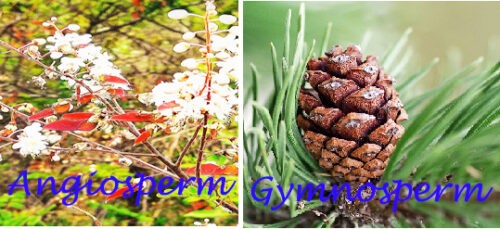Angiosperms are known as flowering plants which include the trees, herbs, and shrubs. They are vascular seed plants and form the largest and most diverse group within the kingdom Plantae. Around 300,000 species of angiosperms are found in the world which represents 80% of all the known green plants. They have a proper root system to collect water and minerals from the soil. Gymnosperms are known as non-flowering plants which are divided into six phyla: Gnetophyta Cycadophyta, Coniferophyta, Ginkgophyta, and Cordaitales (extinct).
More than 1000 species under 88 genera of living gymnosperms are found and distributed throughout the world. Some notable species are pines, cypresses, cycads, gnetophytes such as Ephedra, Gnetum, Welwitschia, and Ginkgo biloba.
Difference Between Angiosperm and Gymnosperm
| Angiosperms | Gymnosperms |
|---|---|
|
Angisoperms are also known as flowering plant. | Gymnosperms are also known as non-flowering plant. |
| They have flattened leaves |
They have scale-like or needle-like leaves. |
| They produce hard wood. | They produce softwood. |
|
They have seeds which are encircled within a fruit. |
They have naked or unclosed seeds on the surface of scales or leaves. |
| The reproductive organ is flower and it is composed of calyx, corolla androcium, and gynocium. | The reproductive organ is cone or trobilus. |
| Flowers are unisexual or bi-sexual. | Flowers are unisexual and naked, calyx and corolla absent. |
| Perianth may be present. | Perianth generally absent (but present in Gnetum). |
| Flowers bear sepals and petals. | Flowers do not have sepals and petals. |
| Flowers bear stigma and style. | Flowers do not have stigma and style. |
|
Short thalamus is present in sporophyll. |
Elongated central axis is present in sporophyll. |
|
Embryonic cotyledons are present which may be single (monocots) or in a pair (dicots). | Embryonic cotyledons are absent. |
|
Reproduction of angiosperm mostly depends on animals. |
Reproduction of angiosperm mostly depends on wind. |
|
The female gametophyte bears seven-celled and eight nucleated embryo sac. |
They have large and parenchymatous female gametophyte. |
|
Inside the ovary of carpel, stalked ovules are present which are attached to the placenta. |
Sessile ovules are present on the megasporophyll. |
|
An ovule is covered by one or two layers of narrow miropyle. |
An ovule is covered by three layers of wide miropyle. |
|
Generally, angisoperms bear four microsporangia or pollen sacs. | |
|
Female reproductive organ, archegonium is absent. |
They have distinct archegonium (plural:archaegoina). |
|
Examples of angiosperms: monocots plants such orchids, lilies, agaves and grasses; and dicots plants such as peas, roses, sunflowers, maples, oaks etc. |
Examples of gymnosperms: pine, spruce, cycas, fir etc. |

Floral Parts of angiosperms

Ovule of Gymnosperm and Angiosperm

Embryonic sac of Angiosperm
Concluding Words
Angiosperms or flowering plants are economically important because they provide timber, fiber, pharmaceuticals, ornamental, and other commercial products while gymnosperms or non-flowering plants produce softwoods which are used to make paper, the lumber, and plywood.

